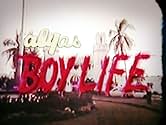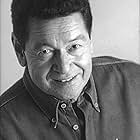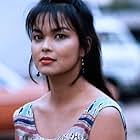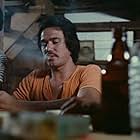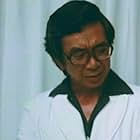Aggiungi una trama nella tua linguaBoy Life is a hardened convict, serving six prison terms--all of them life sentences. Engraved in his flesh are the faces of nine cops whom he must hunt down once he's out of jail.Boy Life is a hardened convict, serving six prison terms--all of them life sentences. Engraved in his flesh are the faces of nine cops whom he must hunt down once he's out of jail.Boy Life is a hardened convict, serving six prison terms--all of them life sentences. Engraved in his flesh are the faces of nine cops whom he must hunt down once he's out of jail.
Foto
Raul Aragon
- Vergara
- (as Raul Aragonn)
Trama
Lo sapevi?
- QuizA true-to- life story of Jaime Juanengco of Navotas, Malabon.
Recensione in evidenza
Manuel "Fyke" Cinco is most probably recognized for his thoughtful dramatization of the life of notorious cop killer, Leonardo "Nards" Delos Reyes aka "Waway" in "Batuigas: Pasukuin Si Waway" which gave the late George Estregan one of his more memorable roles, not to mention bestowing on Rudy Fernandez an award worthy performance. In 1989's Boy Life, the director manages to create an interesting, larger than life depiction of a criminal waging a personal vendetta against rotten policemen.
Playing the thug with serious anger management issues is the charismatic Ricky Davao who is known for an eclectic variety of roles from superhero "Kidlat" in a mid 80s television show to a villain in an action romcom. Davao is a seasoned actor and he has injected into his role a more layered interpretation as a result of his wider acting range. Imagine for example if either the elder Ramon Revilla or Lito Lapid played the role and the result would be much different (though not necessarily bad) because of these guys' minimal acting abilities. Davao though has endowed his character with a more varied personality and not just the usual straightforward caricature of a stereotypical hoodlum.
Supporting Davao in the film is the legendary Eddie Garcia who plays racketeering boss Totoy Magno. Garcia's role is obviously patterned after Marlon Brando's interpretation of Vito Corleone, at least in the duplication of the latter's husky and gravelly voice (Judging from how he exerted much effort in this regard, Garcia most likely had a severe sore throat after the film's completion). The movie also include notable performances by co-stars Tetchie Agbayani and Mark Gil.
On the technical side, the film is a little held back by its drab photography which is mainly caused by the production's low budget. Though to the cinematographer's credit, the night scene gunfights are still quite visible and discernable. The blood effects are kind of deficient at times but not entirely non-existent. The music by Jimmy Fabregas is pretty good and captures the right vibe and tone of each scene. The script by Humilde Roxas is decent though one could see that the plot sort of meanders at certain points such as plot angles that are suddenly abandoned: Boy Life moonlighting as a highway robber and his unresolved relationship with waitress Celia (or is it Delia? I really couldn't make out the name). These plot points are left hanging without being properly wrapped up. Though these are just minor quibs and the film narrative flows with a natural, unhurried pace.
The gun duels in the movie are quite the opposite of most formulaic action films. There's no big shootout inside a warehouse or factory, no scenes of the protagonist mowing down an army of goons with a high powered assault rifle. The gunfights are simple and quite realistic (realism in action films being highly subjective) and works to the film's sense of the unpredictable.
Perhaps the film's biggest strength working to its advantage is in the subtle insertion of morbid humor in otherwise serious and violent sequences. In a scene where a group of cops are having a drinking session, the policeman celebrating his promotion shows off his new uniform and says "Bukas ko na isusuot ito, surpresa sa mga kasama natin (I'll wear this tomorrow as a surprise to our friends)". Out of nowhere, Boy Life shows up and replies "Bukas mo susuotin yan, sa kabaong mo (You'll wear that tomorrow in your coffin)" before clutching the trigger of an Uzi. When a neighborhood toughie with an expansive eagle tattoo covering his chest and stomach (played by Ruel Vernal) tells Boy to come out and fight him, but upon seeing Boy's prison tattoos, his frightened buddies take off leaving him to profusely explain to Boy that he is the old tough guy in town but now they can both share in the notoriety. He then hurries and departs in haste. This clever utilization of blackened humor is best exemplified by the film's final climactic scene which shows that a movie's resolution and denouement about a condemned man doesn't always have to be generic and cliched.
In conclusion, the movie is one of the highlights of Cinco's career as a major action director. It is also Davao's best action film from his occasional forays into the genre along with Takas Sa Impyerno and Canary Brothers Ng Tondo.
Playing the thug with serious anger management issues is the charismatic Ricky Davao who is known for an eclectic variety of roles from superhero "Kidlat" in a mid 80s television show to a villain in an action romcom. Davao is a seasoned actor and he has injected into his role a more layered interpretation as a result of his wider acting range. Imagine for example if either the elder Ramon Revilla or Lito Lapid played the role and the result would be much different (though not necessarily bad) because of these guys' minimal acting abilities. Davao though has endowed his character with a more varied personality and not just the usual straightforward caricature of a stereotypical hoodlum.
Supporting Davao in the film is the legendary Eddie Garcia who plays racketeering boss Totoy Magno. Garcia's role is obviously patterned after Marlon Brando's interpretation of Vito Corleone, at least in the duplication of the latter's husky and gravelly voice (Judging from how he exerted much effort in this regard, Garcia most likely had a severe sore throat after the film's completion). The movie also include notable performances by co-stars Tetchie Agbayani and Mark Gil.
On the technical side, the film is a little held back by its drab photography which is mainly caused by the production's low budget. Though to the cinematographer's credit, the night scene gunfights are still quite visible and discernable. The blood effects are kind of deficient at times but not entirely non-existent. The music by Jimmy Fabregas is pretty good and captures the right vibe and tone of each scene. The script by Humilde Roxas is decent though one could see that the plot sort of meanders at certain points such as plot angles that are suddenly abandoned: Boy Life moonlighting as a highway robber and his unresolved relationship with waitress Celia (or is it Delia? I really couldn't make out the name). These plot points are left hanging without being properly wrapped up. Though these are just minor quibs and the film narrative flows with a natural, unhurried pace.
The gun duels in the movie are quite the opposite of most formulaic action films. There's no big shootout inside a warehouse or factory, no scenes of the protagonist mowing down an army of goons with a high powered assault rifle. The gunfights are simple and quite realistic (realism in action films being highly subjective) and works to the film's sense of the unpredictable.
Perhaps the film's biggest strength working to its advantage is in the subtle insertion of morbid humor in otherwise serious and violent sequences. In a scene where a group of cops are having a drinking session, the policeman celebrating his promotion shows off his new uniform and says "Bukas ko na isusuot ito, surpresa sa mga kasama natin (I'll wear this tomorrow as a surprise to our friends)". Out of nowhere, Boy Life shows up and replies "Bukas mo susuotin yan, sa kabaong mo (You'll wear that tomorrow in your coffin)" before clutching the trigger of an Uzi. When a neighborhood toughie with an expansive eagle tattoo covering his chest and stomach (played by Ruel Vernal) tells Boy to come out and fight him, but upon seeing Boy's prison tattoos, his frightened buddies take off leaving him to profusely explain to Boy that he is the old tough guy in town but now they can both share in the notoriety. He then hurries and departs in haste. This clever utilization of blackened humor is best exemplified by the film's final climactic scene which shows that a movie's resolution and denouement about a condemned man doesn't always have to be generic and cliched.
In conclusion, the movie is one of the highlights of Cinco's career as a major action director. It is also Davao's best action film from his occasional forays into the genre along with Takas Sa Impyerno and Canary Brothers Ng Tondo.
- Nen_Master357
- 4 nov 2021
- Permalink
I più visti
Accedi per valutare e creare un elenco di titoli salvati per ottenere consigli personalizzati
Dettagli
- Colore
Contribuisci a questa pagina
Suggerisci una modifica o aggiungi i contenuti mancanti

Divario superiore
By what name was Alyas: Boy Life (1989) officially released in Canada in English?
Rispondi

